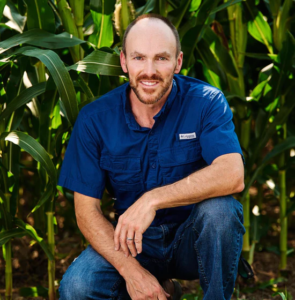Is It Time for a New Vision for Agriculture?

As 2023 gets underway, there’s a lot for farmers to manage, including high energy prices, soaring fertilizer costs, weather challenges and a potentially prolonged period of high interest rates. If it feels like the time to prepare for an uncertain future, that’s right.
“We’re reaching an inflection point in agriculture,” said Brian Dougherty, an Iowa State University Extension ag engineer who spoke at the Big Soil Health Event in Cedar Falls in December. “Survival depends on your ability to change, adapt and manage an evolving system. Prepare now for eminent energy and material constraints—and a fundamentally different economy.”
The most concerning factor is oil, Dougherty emphasized. He noted that 6,000+ products are made from oil, from gasoline and diesel fuel to synthetic fertilizers produced from by-products of the petroleum industry.
“The modern food production and delivery system is dependent on oil. The problem is that the fossil fuel energy needed to continue farming as we do now does not exist. We’re reaching the upper limits of how fast we can extract oil from the ground. Also, annual fossil fuel use rates far exceed fossil fuel formation rates.”
Boosting the efficiency of the current oil-based system isn’t the answer. “Efficiency will not save us,” said Dougherty, citing the Jevons Paradox.
In the 1860s, economist William Stanley Jevons noted that efficiency improvements in coal usage in Scotland from 1830-1863 led to an increase in coal demand, not a decrease, contrary to conventional wisdom. “The Jevons Paradox is still true today,” Dougherty said. “In the long term, more efficient resource leads to greater resource consumption, not less.”
If becoming more efficient isn’t the silver bullet, what about inventing new technology, or going all-electric? Neither will fix the linear system that drives much of modern food production system, Dougherty said.
“In a linear system, you sell your grain to the local co-op, you haul it to the river for shipment, or you sell it to an ethanol plant. Essentially, you’re exporting nutrients off the farm, so you have to acquire more inputs, including fertilizer, to grow the next crop. The linear system does a poor job of recycling, and commodity farmers are on the wrong end of the line.”
What has this linear system resulted in? Rural decay. It’s not just an Iowa challenge, Dougherty added. “This rural decay is occurring worldwide as the number of farms and farmers dwindles, young people have few opportunities to start farming, and small towns are struggling or disappearing.”
Getting the “Dirt” on soil
These aren’t theoretical challenges for Dougherty, a former dairy farmer. “When I was farming with my brother near Waukon, Iowa, I saw where the industry was going. While we were milking 150 to 160 cows, vertical integration meant the industry was moving towards big dairies. I had no desire to milk 1,000 cows or keep taking on more debt my whole life.”
Dougherty went back to school and earned degrees in ecological engineering and ag and biosystems engineering. He also credits David Montgomery’s book Dirt: The Erosion of Civilizations with opening his eyes to a new view for agriculture. Combining a mix of history, archaeology and geology, this book explores how humans have used and abused soils through the centuries. Once bare of protective vegetation and exposed to wind and rain, cultivated soils erode bit by bit, slowly enough to be ignored in a single lifetime, but fast enough over centuries to limit the lifespan of entire civilizations. “This book changed my life,” Dougherty said.
As he connected the dots, he could see that the consequences of the linear, oil-based food production system will accumulate, especially as the global population continues to grow. “Perpetual growth is impossible on a finite planet. Our linear food system will fail, because we’re on a collision course with the biophysical limits of the planet. We need a new vision for agriculture.”
Regenerative ag increases resilience
Dougherty, who calls himself a “student of soil,” views regenerative agriculture as a viable, local solution to this global challenge. “Regenerative ag is a circular system defined by recycling, regeneration and resilience,” he said. “It uses biological principles to reconnect the links between soil health and the health of plants, animals and people.”
This doesn’t mean switching to all-organic production or going back to the days of horse-drawn farm equipment. It does mean moving away from soil degeneration, which includes leaving soil bare, excessive tillage, erosion, reduced organic matter and soil nutrients, poor soil structure and anaerobic soil conditions that don’t support the beneficial microorganisms essential for soil health.
“Farming this way is a broken system, and we’ve been attempting to fix it with fertilizer, tillage and pesticides,” Dougherty said.
He’s even coined a term for this approach: “fertillicide.” “This is the excessive use of fertilizers, tillage and/or pesticides as a means to control nature in pursuit of food production and wealth. It ultimately leads to the demise of civilizations, due to the degradation of ecosystems that support life.”
Dougherty embraces a regenerative system of agriculture that harnesses the power of soil biology. “If you focus on building soil aggregates, you’re 75% of the way to healthier, more productive soil,” he noted.
Beneficial microorganisms like earthworms, mycorrhizal fungi and other helpful microbes in the soil help build these soil aggregates. Better soil structure leads to better water infiltration and more oxygen in the soil. This is good for beneficial soil microorganisms and plant roots, which in turn leads to healthier plants.
Improved soil health and improved soil aggregation lead to less erosion, less nutrient loss and more organic matter, which helps nourish more productive crops. “Soil is the battery of life,” Dougherty said. “Increased biological activity and accessible carbon help recharge that battery. When you have a naturally functioning system like this, it means you spend less money trying on chemicals and tillage to fix problems.”
To stop committing fertilicide and take steps towards regenerative agriculture, Dougherty recommends a variety of soil health principles:
- Wean off fertillicide slowly (eliminate fungicides, start cutting back on insecticides, reduce herbicide rates, reduce purchased fertilizer inputs).
- Fix soil compaction.
- Reduce tillage.
- Nurture the soil food web and build soil organic matter. Use crop rotation and cover crops to support this process, which helps beneficial soil microorganisms thrive. Think of the soil microbiome like the human gut microbiome. “We’ve learned a lot about the gut microbiome in the last 20 years and the role that these beneficial bacteria, fungi and other microorganisms play in human health,” Dougherty said. “We want beneficial microbes to work in the soil, too.”
- Apply livestock manure to your fields. No livestock? Bring in compost, or buy manure from a neighbor.
“All this helps re-weave the soil health web,” Dougherty said.
Learn with ProfitProAG
You don’t have to go it alone. Dougherty is a big fan of the power of scenius to share knowledge and solve challenges.
“Scenius” is a term coined by musician and producer Brian Eno to counter the lone-genius myth, or the idea that innovation comes from just a few select people. Scenius is collective genius applied to problem solving. ProfitProAG’s upcoming 2023 Winter Conference (Feb. 16-17) encompasses the tenets of scenius, including mutual appreciation for the challenges at hand; rapid exchange of tools, techniques and knowledge; networking; a flourishing space for nonconformity, where unconventional, revolutionary ideas are encouraged; and success is celebrated by everyone.
Dougherty looks forward to meeting you at the conference and encourages you to keep learning about soil health and the advantages of regenerative ag. “This is an incredible opportunity for agriculture. It all starts with the soil. Healthy soil is the foundation of resilient farms, healthy people and revitalized communities.”
